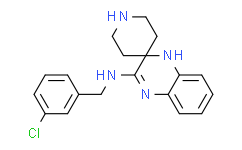| Cas No.: | 950455-15-9 |
| Chemical Name: | Liproxstatin-1 |
| Synonyms: | Liproxstatin-1;N-[(3-Chlorophenyl)methyl]-spiro[piperidine-4,2′(1′H)-quinoxalin]-3′-amine;N-[(3-chlorophenyl)methyl]spiro[4H-quinoxaline-3,4′-piperidine]-2-amine;Liproxstatin 1;BCP15985;DNDI1417503;s7699;AK548157;J3.631.135E;N-(3-Chlorobenzyl)-1'H-spiro[piperidine-4,2'-quinoxalin]-3'-amine;N-(3-Chlorobenzyl)spiro[quinoxaline-2(1H),4'-piperidine]-3-amine;N-[(3-chlorophenyl)methyl]spiro[4H-quinoxaline-3,4'-piperidine]-2-amine;N-[(3-chlorophenyl)methyl]-1'H-spiro[piperidine-4,2'-quinoxa |
| SMILES: | ClC1=C([H])C([H])=C([H])C(=C1[H])C([H])([H])/N=C1/C2(C([H])([H])C([H])([H])N([H])C([H])([H])C2([H])[H])N([H])C2=C([H])C([H])=C([H])C([H])=C2N/1[H] |
| Formula: | C19H21ClN4 |
| M.Wt: | 340.8498 |
| Sotrage: | 2 years -20°C Powder, 2 weeks 4°C in DMSO, 6 months -80°C in DMSO |
| Description: | Liproxstatin-1 is a potent ferroptosis inhibitor, with IC50 of approximately 38 nM. |
| In Vivo: | Liproxstatin-1 (10 mg/kg, i.p.) suppresses ferroptosis in human cells, Gpx4−/− kidney and in an ischaemia/reperfusion-induced tissue injury model[1]. |
| In Vitro: | Liproxstatin-1 prevents BODIPY 581/591 C11 oxidation in Gpx4−/− cells. Moreover, Liproxstatin-1 does not interfere with other classical types of cell death, such as TNFα-induced apoptosis and H2O2-induced necrosis, and in the bona fide L929 model of TNFα/zvad-induced necroptosis[1]. Liproxstatin-1 has great antiferroptotic activity with EC50 of appr 38 nM. Fer-1 and Liproxstatin-1 are inherently good, but not great, radical-trapping antioxidants, but they are excellent in phospholipid bilayers. Fer-1 (10 μM) and Liproxstatin-1 (10 μM) do not exhibit significant inhibitory activity in the 15-LOX-1 overexpressing cells, and the concentration is almost 1000-fold higher than their EC50s for subverting RSL3-induced ferroptosis in these cells (15 and 27 nM, respectively)[2]. |

 DC Chemicals' products qualify for U.S. tariff exemptions. We guarantee no price increases due to customs duties and maintain stable supply, continuing to deliver reliable research solutions to our American clients.
DC Chemicals' products qualify for U.S. tariff exemptions. We guarantee no price increases due to customs duties and maintain stable supply, continuing to deliver reliable research solutions to our American clients.





















